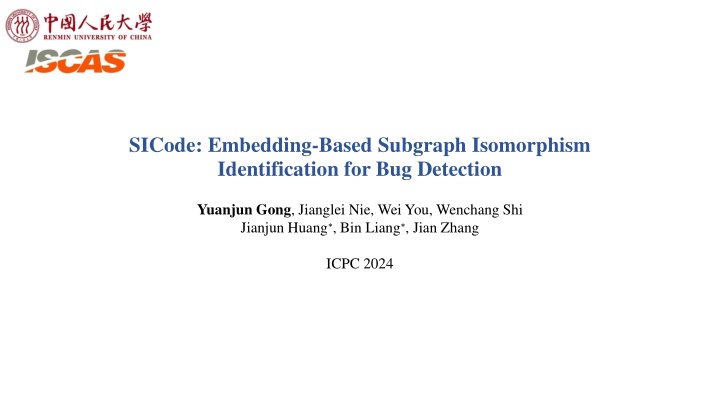
Embedding-Based Subgraph Isomorphism for Bug Detection
Explore how SICode utilizes embedding-based subgraph isomorphism identification to detect bugs in code efficiently. Learn about the challenges in subgraph matching algorithms and the solution offered by graph neural networks. Dive into the approach of SICode in training embedding models and detecting buggy code using vector space embeddings.
Download Presentation

Please find below an Image/Link to download the presentation.
The content on the website is provided AS IS for your information and personal use only. It may not be sold, licensed, or shared on other websites without obtaining consent from the author. If you encounter any issues during the download, it is possible that the publisher has removed the file from their server.
You are allowed to download the files provided on this website for personal or commercial use, subject to the condition that they are used lawfully. All files are the property of their respective owners.
The content on the website is provided AS IS for your information and personal use only. It may not be sold, licensed, or shared on other websites without obtaining consent from the author.
E N D
Presentation Transcript
SICode: Embedding-Based Subgraph Isomorphism Identification for Bug Detection Yuanjun Gong, Jianglei Nie, Wei You, Wenchang Shi Jianjun Huang , Bin Liang , Jian Zhang ICPC 2024
1. Introduction Detecting bugs based on code-matching is feasible Matched?
The two functions differ globally, but they have sub-structural similarities in the highlighted statements
Basic Idea Subgraph isomorphism identification - find potential bugs by checking whether an approximate copy of the buggy subgraph exists within the target code graphs Challenge: Exact subgraph-matching algorithms are time-consuming VF2 takes more than 3 hours to compare one query across the Linux Kernel project Solution: Embedding-based subgraph detection with graph neural networks - effective and efficient
2. Our approach SICode (Subgraph Isomorphism-based buggy Code detection) Step1 Training the embedding model Step2 Embedding the target functions into vector space Step3 Embedding the query graph, get the detection result Target Vectors Query Vector
Graph Preparation Method: devm_kzalloc Method: devm_clk_get Graph generation Transform the function into CFG and DDG via fuzzyc2cpg Merge the CFG and the DDG into a hybrid graph Prune the less meaningful nodes Encoding nodes to labels Return - label 0 Operator - label [1, ?? ] Invoked method - label [?? + 1, ?? + ??] fastText embedding K-means clustering Method: IS_ERR Method: clk_prepare_enable Method: clk_get_rate 212 212 129 150 26 0 1 ??+1 ??+??+1
Embedding Model k GIN-layers - Propagate information from the k-order neighbors to the node (?)= ???? (? 1) ? 1+ 1 + ?(?) ? ? ? ? ? ? Graph representation -Aggregate the node representation (?) ??= ???? ??????0 ? ? ? ? ?
Embedding Model a ? 212 b 212 212 129 129 212 129 150 150 26 26 150 26 a b S Vector Space We propose a cascading loss function to train the embedding model.
Embedding Model The cascading loss function is composed of the loss on positive and negative samples ? ?,?,? = ?????,? + ????(?,?) A positive training instance includes a series of graphs in the form of ?0, ,?? in which ?? is subgraph-isomorphic to ??+1 ? ?,?< ? ?????,? = (max{0,? ?? 1 ? ? ?? ?+ ?????????}) ?=1,?=0
Embedding Model A negative training instance includes a series of graphs in the form of S,?1 ,?? in which S is not a subgraph of N?and N? is subgraph- isomorphic to N?+1 ? ? ?????,? = (max{0,????????? ? ? ?(?,??)}) ?=1 W (violation score) quantizes how much ? ?? exceeds ? ?? ?< ? 2 ? ??,?? = max 0,? ??? ? ?? ? ?=0
Embedding Model To train a project-unspecific model, we use a backbone scheme to generate training samples Method: devm_kzalloc Method: devm_clk_get M 101 extracting instantiating M 111 M 103 Method: IS_ERR Method: clk_prepare_enable M 123 M 120 Method: clk_get_rate
Bug Detection The target graphs are ?-hop subgraphs extracted from the target project, in case the candidate functions are too large and unable to be embedded by a fixed-depth graph neural network adequately. A ?-hop target graph starts from an invocation node, and all reachable neighbors and edges within ? hops are included. The target graphs are encoded and embedded into the vector space.
Bug Detection The query graph is a subgraph of the buggy function graph. Every node and edge should be closely related to the bug logic. Find the center node Program slicing Remove unrelated nodes The query graph is encoded and embedded into the vector space.
Bug Detection The isomorphism can be determined by performing two vector calculations Target contains all the node features that Query has ???? ? ????? The violation score that Query is a subgraph of Target is within the tolerance ? ??,?? < ? Manually audit the top-ranked graphs (ranking by the violation score W) and report discovered bugs to the developers
3. Evaluation Scalability Evaluate the runtime of SICode about subgraph isomorphism decisions on Linux v5.17, VLC, and OpenSSL Embedding-based subgraph isomorphism method has shown great scalability compared to classic algorithms
Effectiveness Test the subgraph matching models performance w/wo cascading loss function The cascading loss suits this problem well
Effectiveness Audit the reports from five tools based on the same buggy queries SICode finds the most bugs and achieves the highest R@10 and R@20
4. Conclusion We design a novel bug detection method, SICode, with embedding- based subgraph isomorphism identification. Subgraph isomorphism relations are encoded in the vectors and hence vector-based comparison can support scalable subgraph isomorphism decisions. We propose a cascading loss function to train the embedding model, and greatly improve the model s isomorphism identification. SICode spotted 20 real-world bugs, among which, 18 bugs were confirmed by the developers. This result is very encouraging for detecting subtle sub-structurally similar bugs. performance of subgraph
